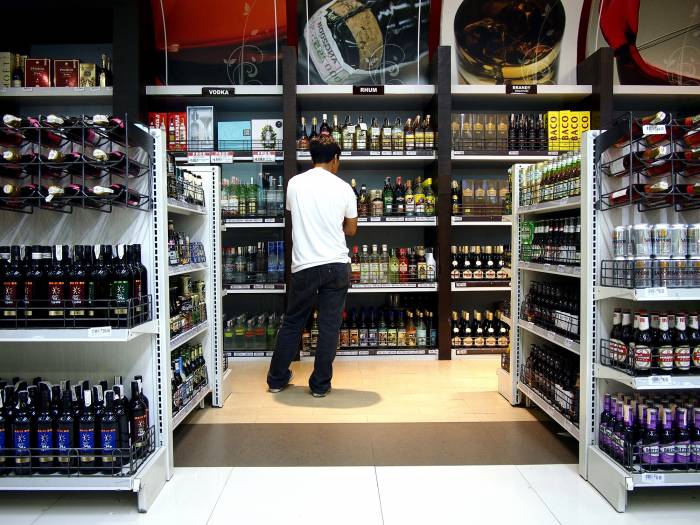Americans Rethink Alcohol Purchases as Convenience Store Trends Shift
Ready-to-drink cocktails and spirits gain ground while beer and wine face challenges amid changing consumer attitudes and wellness focus
2025-10-09

Alcohol sales in convenience stores across the United States have seen notable shifts in recent years, with some categories experiencing growth while others continue to lose ground. According to recent data and industry experts, these changes reflect broader cultural trends, evolving consumer preferences, and the impact of wellness movements.
A Gallup poll released this year found that only 54% of Americans now say they drink alcohol, the lowest figure on record. This decline coincides with a growing belief that even moderate alcohol consumption is harmful to health, a view now held by the majority of Americans for the first time. Samantha Bomkamp Des Jardins, content marketing manager at Datassential, noted that more time spent at home, increased focus on wellness, and the popularity of hydration are all influencing how Americans approach drinking.
Despite these trends, Datassential’s Buzz: Q2 2025 report shows that alcohol consumption actually ticked up slightly in the first half of 2025 after a steady decline throughout 2024. This suggests that consumer interest in alcohol may be stabilizing or even rebounding in some areas.
Beer remains the top-selling alcoholic beverage in convenience stores, even as its dominance is challenged. Circana data shows that beer dollar sales in c-stores declined by 1.6% and case volume fell by 3.8% in the year ending August 10. Still, beer and related products generated more than $25 billion in c-store sales over the past year. Mike Wyatt, principal for client insights at Circana, said that while overall beer sales are down, craft and import beers are seeing modest growth. Domestic super premium beers like Blue Moon and Michelob Ultra have outperformed other segments, driven by strong brand performance.
However, beer’s momentum appears to be slowing further. A Goldman Sachs retailer survey from the second quarter of this year found that c-store beer sales trends decelerated compared to the first quarter, leading retailers to adopt a more cautious outlook for the rest of the year.
Ready-to-drink (RTD) alcoholic beverages and canned cocktails have emerged as major winners in c-store alcohol sales. More than half of consumers report buying more RTDs over the past two years, reflecting a demand for convenience and variety. Hard seltzers such as White Claw and Bud Light Seltzer have grown by 453% over four years. Premixed cocktails like Buzzballz and BeatBox have outpaced both hard seltzers and flavored malt beverages, with c-store sales of premixed cocktails jumping nearly 56% in the past year and case volume up by 66.5%.
Spirits are also gaining ground across all retail channels. Tequila stands out with a 13.8% increase in sales year over year, attributed to improved quality, diverse flavor profiles, and versatility in cocktails. Wyatt said tequila has become popular among both former whiskey drinkers and new consumers exploring spirits.
Wine sales tell a different story. The category has been declining across all retail outlets, including c-stores. Over the past year, wine dollar sales dropped 4.3% and case sales fell 7%, according to Circana. Wyatt explained that wine is often a planned purchase rather than an impulse buy, which does not align well with typical c-store shopping habits. Additionally, wine assortments in c-stores have shrunk by 16% over the past three years as operators adjust their offerings to match consumer demand.
Low- and no-alcohol beverages are growing in popularity overall but remain a small part of c-store sales. Low- and no-alcohol beer now accounts for 2.5% of total beer sales across all channels but just 0.3% in c-stores. The same pattern holds for non-alcoholic wine.
Industry experts caution against writing off any segment entirely. Wyatt emphasized that while some categories are currently underperforming, alcohol remains an important category for both consumers and retailers. Shifts within the market are common as consumer tastes evolve and new buyers enter the space.
The landscape for alcoholic beverages in convenience stores continues to change as Americans reconsider their drinking habits and seek new products that fit their lifestyles. While some traditional categories struggle, others are finding new opportunities for growth amid changing preferences and cultural attitudes toward alcohol.
Founded in 2007, Vinetur® is a registered trademark of VGSC S.L. with a long history in the wine industry.
VGSC, S.L. with VAT number B70255591 is a spanish company legally registered in the Commercial Register of the city of Santiago de Compostela, with registration number: Bulletin 181, Reference 356049 in Volume 13, Page 107, Section 6, Sheet 45028, Entry 2.
Email: [email protected]
Headquarters and offices located in Vilagarcia de Arousa, Spain.